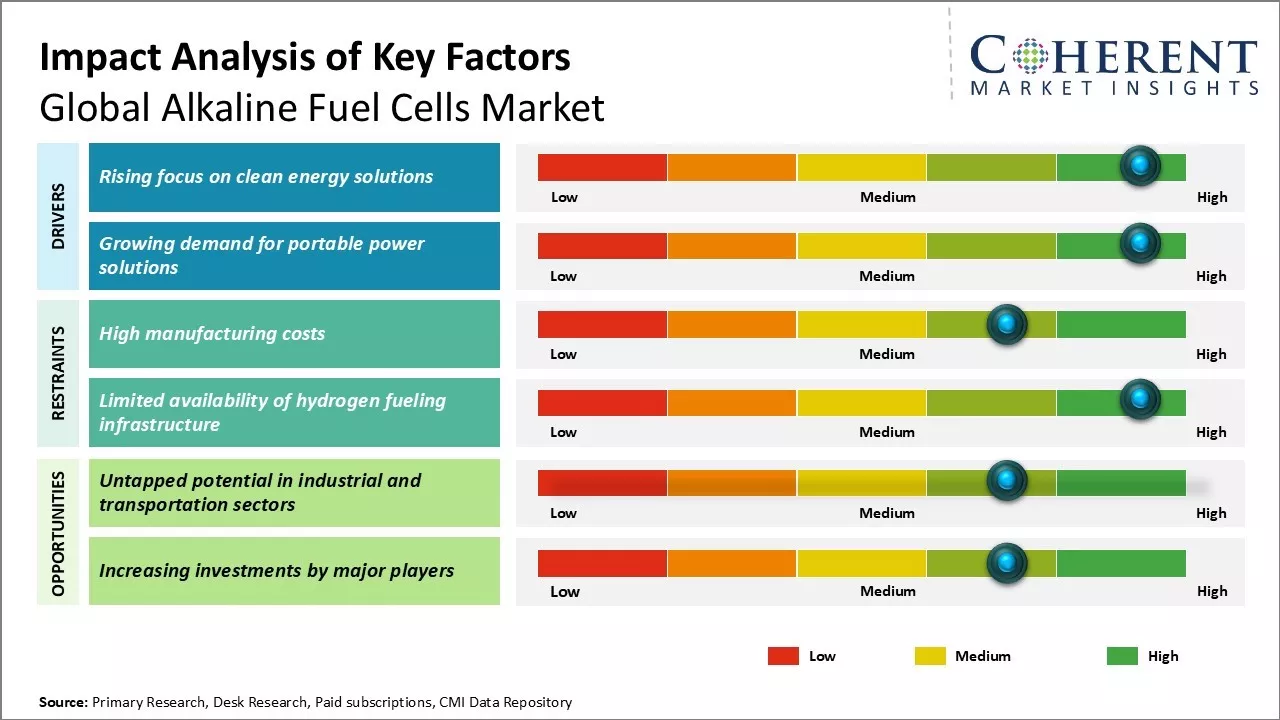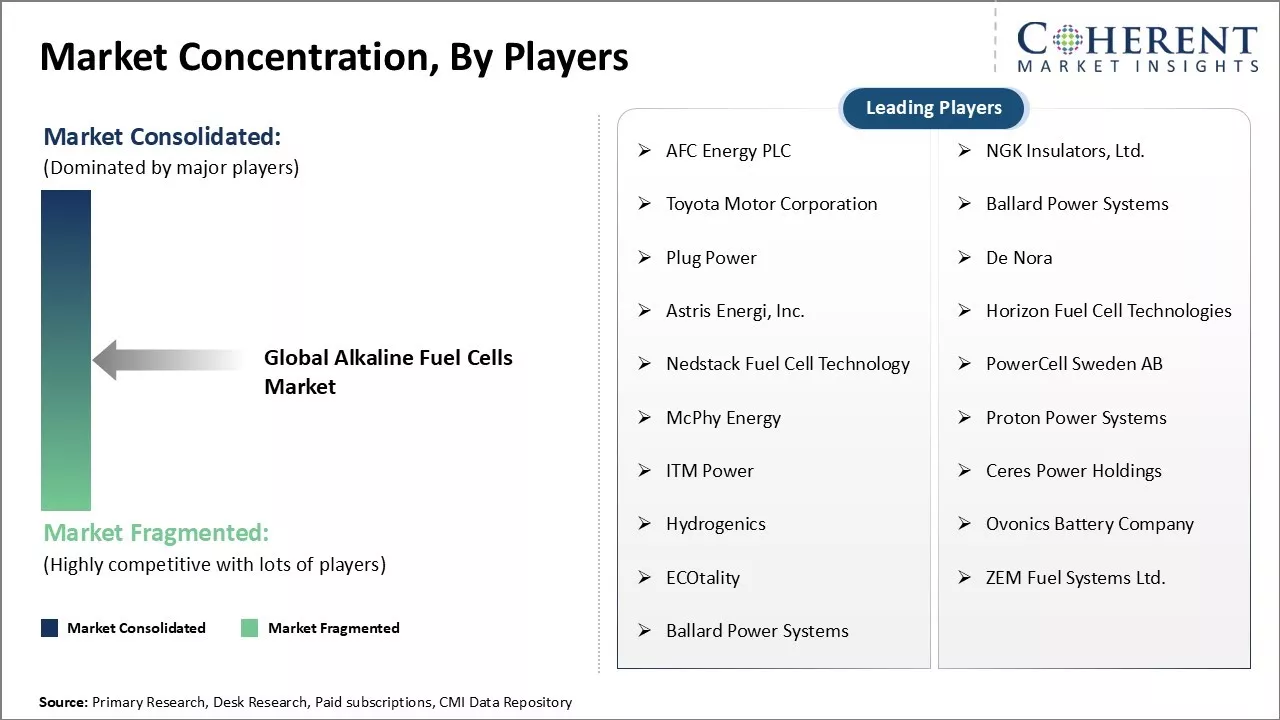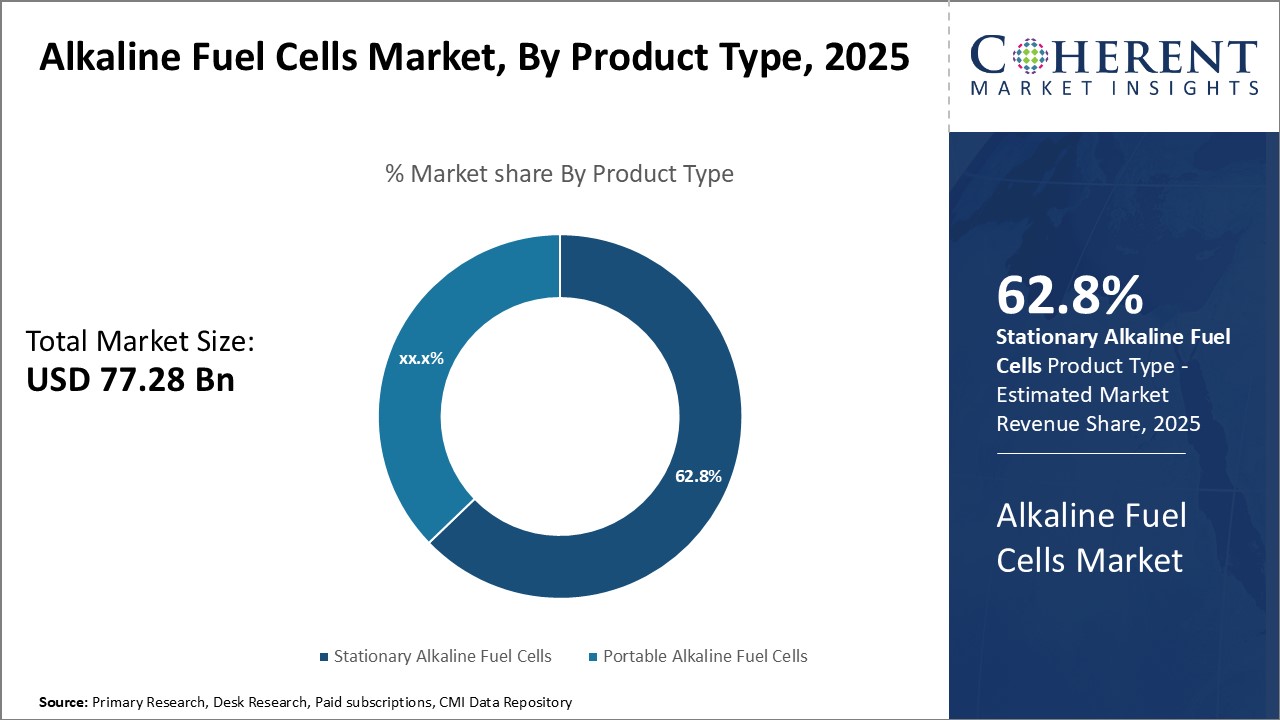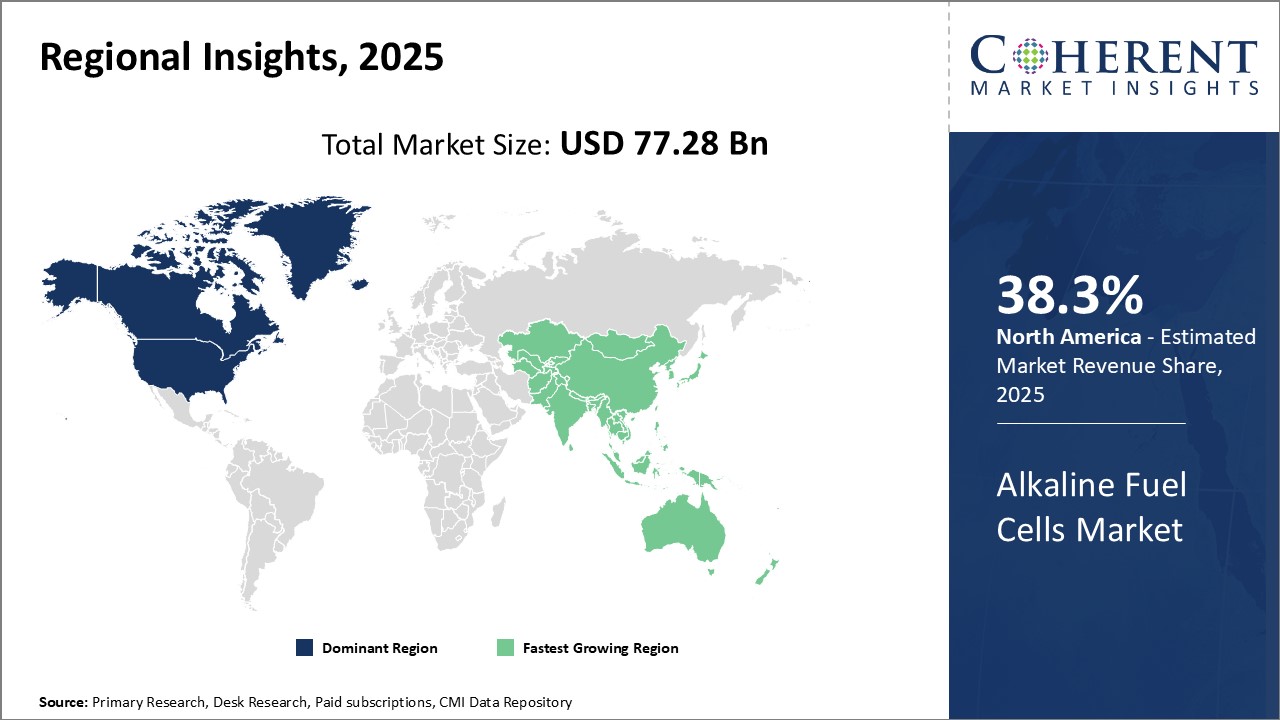Alkaline Fuel Cells Market Size and Trends
The global alkaline fuel cells market is estimated to be valued at USD 77.28 Billion in 2025 and is expected to reach USD 135.13 Billion by 2032, exhibiting a compound annual growth rate (CAGR) of 8.3% from 2025 to 2032.

Discover market dynamics shaping the industry: Download Free Sample
Alkaline fuel cells provide efficient energy with zero emission making them an attractive investment for many countries and organizations.
Market Driver - Rising focus on clean energy solutions
The world is facing serious issues related to climate change and global warming due to heavy reliance on fossil fuels for energy needs. Greenhouse gas emissions from fossil fuel usage is widely acknowledged to be one of the leading contributors to rising Earth's temperatures. There is a growing push from governments, environmental agencies, and public to shift towards cleaner and renewable sources of energy in order to curb pollution levels and limit further damage to the environment. Alkaline fuel cells offer a promising clean energy alternative as they generate electricity through an electrochemical reaction between alkaline metal such as zinc and oxygen without combustion. The cells have advantages such as zero emissions during operation, high energy density, and ease of use.
Many countries have set ambitious targets to increase the share of renewable sources in their energy mix to meet commitments under the Paris Agreement. Expanding production and usage of alkaline fuel cells can help nations lower dependence on oil and gas. The technology allows for clean off-grid power in remote locations as well as portable backup power supply. Major application areas include consumer electronics, emergency lighting, electric vehicles, etc. The European Union has taken a lead and formulated legislation to promote the adoption of green hydrogen technologies of which alkaline fuel cells are a part. Governments provide funding and incentives to drive local manufacturing and deployment. Even individual consumers are becoming environmentally conscious and opting for products powered by clean energy alternatives whenever feasible.
With growing worldwide acceptance that urgent action needs to be taken to switch to non-polluting energy sources, alkaline fuel cells are gaining credence as an eco-friendly option. Policy support and public preference for sustainability are compelling factors that are likely to sustain the rising focus on clean energy solutions and propel the demand for alkaline fuel cells over the foreseeable future.
Market Concentration and Competitive Landscape

Get actionable strategies to beat competition: Download Free Sample
Growing need for portable power
World today has become highly mobile and fast-paced, with people constantly on the go. Long hours outside home and workplace has increased reliance on portable devices that keep us connected without needing a fixed power source - smartphones, laptops, cameras, medical equipment, outdoor recreational gear, and others. However, batteries within these devices have limited life and need to be frequently recharged which can be inconvenient especially during travels or outdoor activities far from power outlets. This growing demand for sustained mobile power without constraints of cables or fixed infrastructure has opened up opportunities for lightweight and long-lasting portable energy storage systems such as alkaline fuel cells.
Alkaline fuel cells are ideally suited to fulfill the mobility requirement, as they are small in size, have high energy density owing to compressed hydrogen fuel and can deliver power continuously for extended durations compared to conventional batteries of same weight and volume. Their natural long shelf-life of up to a year without usage is also very suitable for stand-by emergency applications. Military, disaster relief teams and outdoor professionals already use fuel-cell-powered devices extensively due to reliability needs. Even for everyday consumer needs, their ease of operation makes them user-friendly for casual users less technically inclined. Rapidly expanding outdoor recreational activities are creating more instances where sustained power is essential but grid connection impossible. Increase in smartphones and tablets usage on the move is another driver of the mobile energy demand.
With lifestyles and technologies focusing more on flexible usage away from fixed locations, there is a growing appreciation of reliable yet conveniently portable power sources that can keep pace with active outdoor mobile living. Alkaline fuel cells are attracting much attention from users and manufacturers alike to tap this expanding business opportunity around continuous power solutions for portable applications.
Key Takeaways from Analyst:
Major drivers for adoption will be the technology's ability to provide clean and efficient energy for various applications. Alkaline fuel cells can replace internal combustion engines and batteries in many use cases due to their high energy density and low emissions. The transportation sector is expected to drive a significant share of demand as automakers look to adopt alternative powertrain technologies. Stationary and portable power generation also present opportunities to utilize alkaline fuel cells' advantages over traditional sources.
High manufacturing and fuel costs pose restraints to wider commercialization. Additionally, lack of supporting infrastructure can limit expansion into its most suitable end uses like passenger EVs. Technology challenges in improving durability and lifespan while bringing down costs may slow the market's trajectory.
Regions like North America and Europe are forecasted to dominate initial alkaline fuel cell deployments aided by government funding and early adoption initiatives. Meanwhile, Asia Pacific's fuel cell developers expect to ramp up production capacities and become the fastest growing regional market. Growing research collaborations between developers, system integrators, and end users also present opportunities to accelerate performance improvements and commercial viability. Wider field trials across target sectors will be crucial to prove the technology’s practical applications at scale.
Market Challenge - High manufacturing costs
One of the major challenges faced by the global alkaline fuel cells market is the high manufacturing costs associated with alkaline fuel cell technology. Alkaline fuel cells utilize expensive catalyst materials like platinum and ruthenium to facilitate the reaction between hydrogen fuel and oxygen. The precious metal catalysts account for a significant portion of the total manufacturing costs. Additionally, alkaline fuel cells require highly pure hydrogen fuel to function efficiently. Producing hydrogen at a large scale and guaranteeing its purity throughout the supply chain also adds to the costs. The other components of alkaline fuel cells like membranes, bipolar plates, and sealing materials contribute to further driving up the overall production expenses. Unless mass production and economies of scale help drive down these costs significantly, high manufacturing costs will continue to deter the widespread commercialization of alkaline fuel cells.
Market Opportunity - Untapped Potential in Industrial and Transportation Sectors
A major opportunity for the global alkaline fuel cells market lies in tapping the untapped potential of the industrial and transportation sectors. Currently, applications of alkaline fuel cells are largely limited to niche markets like aerospace, defense, and portable power. However, industries as well as commercial transportation have significant scope for adopting alkaline fuel cell technology for their power requirements. Factories and manufacturing facilities can deploy alkaline fuel cells for reliable on-site power generation. Similarly, material handling vehicles, forklifts, trucks, and buses present a large addressable market where alkaline fuel cells can replace aging battery technologies. Penetration of fuel cells in these sectors will help drive volume growth and realize economies of scale to eventually bring down costs. It will also establish alkaline fuel cells as a viable clean energy alternative to fossil fuel-based options in industrial and transportation power.

Discover high revenue pocket segments and roadmap to it: Download Free Sample
Insights by product type: Adaptability for large-scale stationary power applications
In terms of product type, stationary alkaline fuel cells contributes the highest share of the market. Stationary alkaline fuel cells are highly suited for large-scale stationary power applications due to their ability to provide reliable and continuous base-load electricity with near-zero emissions. Their modular design allows for scalable power output ranging from kilowatts to multi-megawatts, enabling them to meet the baseload electricity needs of a variety of commercial and industrial facilities.
The steady power output and high reliability of stationary alkaline fuel cells are highly valued for applications such as primary and backup power for telecom towers, data centers, hospitals, and other critical infrastructure. Their siting flexibility allows for indoor or outdoor installation depending on space and operational requirements. Furthermore, their compact size and light weight relative to output reduce costs related to transportation and installation at the deployment site.
The lack of moving parts and less frequent replacement of consumables compared to other fuel cell technologies also lower the maintenance needs of stationary alkaline fuel cells. This improves their operational economics for commercial customers with round-the-clock electricity demands. With increasing corporate sustainability commitments, the clean emissions profile of stationary alkaline fuel cells is another driving factor for their adoption in stationary power generation applications over traditional diesel gensets.
Insights by application: Growing concerns about energy security and environmental sustainability
In terms of application, residential contributes the highest share of the market. The residential sector accounts for the largest share of the global alkaline fuel cells market driven by growing consumer concerns about energy security and environmental sustainability. Alkaline fuel cells provide homeowners with a reliable backup power source to meet their basic electricity needs during utilities grid outages caused by extreme weather or natural disasters. This is a major advantage as power disruptions can last for days in affected areas.
Rising environmental consciousness among homeowners is also boosting sales. Alkaline fuel cells do not emit any harmful pollutants during operation and are an eco-friendlier alternative to diesel or gasoline generators. With governments across countries implementing stricter emission regulations, residential fuel cells are gaining traction. Moreover, certain financial incentives and tax credits offered by some local and state administrations on renewable energy technologies make alkaline fuel cells economically viable for residential use.
Their quiet operation without loud noise or vibrations has further increased their desirability for deployment in households. The easy refueling with readily available hydrogen fuel cartridges also makes maintenance hassle-free. This coupled with decreasing alkaline fuel cell prices is expected to see continued growth in their residential application over the forecast period.
Regional Insights

Need a Different Region or Segment? Download Free Sample
North America has established itself as the dominant region in the global alkaline fuel cells market. The region is expected to hold 38.3% of the market share in 2025. The region is home to some of the major players operating in the industry who have been focusing on R&D activities to develop advanced alkaline fuel cell technologies. Stringent emission norms and growing focus on reducing the carbon footprint have further accelerated alkaline fuel cell adoption in the transportation and stationary power sectors. Moreover, substantial government funding in the U.S. and Canada towards new clean energy projects involving fuel cells has boosted the regional market growth. The alkaline fuel cells market has a strong foothold in North America with major manufacturers located across the U.S. and Canada.
Asia Pacific has emerged as the fastest growing regional market for alkaline fuel cells globally. Rapid industrialization and urbanization have increased energy demands across developing countries like China and India. This presents opportunities for alkaline fuel cells to provide decentralized power across off-grid locations. Further, the presence of a large automotive industry and consumer demand for electric vehicles in countries like Japan and South Korea is contributing to the regional market expansion. Local governments are implementing initiatives to develop indigenous fuel cell technologies and attract foreign investments, which will aid technology transfer and commercialization. The large production bases of alkaline fuel cell components give Asia Pacific manufacturers an edge in exports. Lower production costs compared to North America and Europe have made Asia Pacific an attractive production hub for alkaline fuel cells. This is positively impacting the regional market growth.
Market Report Scope
Alkaline Fuel Cells Market Report Coverage
| Report Coverage | Details | ||
|---|---|---|---|
| Base Year: | 2024 | Market Size in 2025: | USD 77.28 Bn |
| Historical Data for: | 2020 To 2024 | Forecast Period: | 2025 To 2032 |
| Forecast Period 2025 to 2032 CAGR: | 8.3% | 2032 Value Projection: | USD 135.13 Bn |
| Geographies covered: |
|
||
| Segments covered: |
|
||
| Companies covered: |
AFC Energy PLC, NGK Insulators, Ltd., Toyota Motor Corporation, Ballard Power Systems, Plug Power, De Nora, Astris Energi, Inc., Horizon Fuel Cell Technologies, Nedstack Fuel Cell Technology, PowerCell Sweden AB, McPhy Energy, Proton Power Systems, ITM Power, Ceres Power Holdings, Hydrogenics, Ovonics Battery Company, ECOtality, ZEM Fuel Systems Ltd., and Ballard Power Systems |
||
| Growth Drivers: |
|
||
| Restraints & Challenges: |
|
||
Uncover macros and micros vetted on 75+ parameters: Get instant access to report
Alkaline Fuel Cells Industry News
- In January 2024, NASA's Moon-Shot initiative kickstarted the commercial fuel cell industry
- In 2023, Alkaline Fuel Cell Power Corp. announced the launch of its prototype, the Jupiter 1.0, a robust fuel cell system designed for residential and small building applications, along with a management update
*Definition: The global alkaline fuel cells market consists of companies that manufacture and sell alkaline fuel cell technology to be used for commercial and industrial applications. Alkaline fuel cells use potassium hydroxide as the electrolyte instead of acids. They have higher power densities and are more resistant to carbon dioxide poisoning compared to polymer electrolyte membrane fuel cells.
Market Segmentation
- Product Type Insights (Revenue, USD Bn, 2020 - 2032)
-
- Stationary Alkaline Fuel Cells
- Portable Alkaline Fuel Cells
- Application Insights (Revenue, USD Bn, 2020 - 2032)
-
- Residential
- Commercial
- Military & Aerospace
- Transportation
- Regional Insights (Revenue, USD Bn, 2020 - 2032)
-
- North America
- U.S.
- Canada
- Latin America
- Brazil
- Argentina
- Mexico
- Rest of Latin America
- Europe
- Germany
- U.K.
- Spain
- France
- Italy
- Russia
- Rest of Europe
- Asia Pacific
- China
- India
- Japan
- Australia
- South Korea
- ASEAN
- Rest of Asia Pacific
- Middle East
- GCC Countries
- Israel
- Rest of Middle East
- Africa
- South Africa
- North Africa
- Central Africa
- North America
- Key Players Insights
- AFC Energy PLC
- NGK Insulators, Ltd.
- Toyota Motor Corporation
- Ballard Power Systems
- Plug Power
- De Nora
- Astris Energi, Inc.
- Horizon Fuel Cell Technologies
- Nedstack Fuel Cell Technology
- PowerCell Sweden AB
- McPhy Energy
- Proton Power Systems
- ITM Power
- Ceres Power Holdings
- Hydrogenics
- Ovonics Battery Company
- ECOtality
- ZEM Fuel Systems Ltd.
- Ballard Power Systems
Share
Share
About Author
Yash Doshi is a Senior Management Consultant. He has 12+ years of experience in conducting research and handling consulting projects across verticals in APAC, EMEA, and the Americas.
He brings strong acumen in helping chemical companies navigate complex challenges and identify growth opportunities. He has deep expertise across the chemicals value chain, including commodity, specialty and fine chemicals, plastics and polymers, and petrochemicals. Yash is a sought-after speaker at industry conferences and contributes to various publications on topics related commodity, specialty and fine chemicals, plastics and polymers, and petrochemicals.
Missing comfort of reading report in your local language? Find your preferred language :
Transform your Strategy with Exclusive Trending Reports :
Frequently Asked Questions
EXISTING CLIENTELE
Joining thousands of companies around the world committed to making the Excellent Business Solutions.
View All Our Clients
